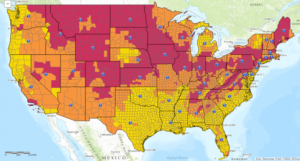So in utility and policy circles, electrification is all the rage. Grid electricity is getting cleaner (i.e. resulting in lower CO2 emissions), on-site renewables are taking off (sometimes even with storage), and heat pump technologies are getting better. More regional and utility initiatives are encouraging building owners/designers/developers to forego onsite fossil fuels entirely (or at least mostly) to help meet CO2 emission reduction goals. But is electricity really more sustainable than natural gas? Is it cheaper? Which is better, really?
The Second Leading Cause of Lung Cancer May Not be What You Expect
National Public Health Week is this week and Today’s theme is “Environmental Health”, which includes protecting and maintaining a healthy indoor environment.
While National Radon Action Month was in January, we wanted to share how this specific indoor air pollutant can affect your health and what compelled a group of us here at SWA to get our homes tested (and remediated).
What is radon and why does it matter?
Radon gas is a naturally occurring byproduct of the radioactive decay of uranium found in some rock and soil. You can’t see, smell or taste radon, but it may be found in drinking water and indoor air. This carcinogenic gas is currently the second leading cause of lung cancer after smoking, according to the National Cancer Institute.
Although radon in drinking water is a concern, radon in soil under homes is the biggest source of radon, and presents the greatest risk to occupants. This pressure-driven mechanism occurs when radon escaping the soil encounters a negative pressure in the home relative to the soil. This pressure differential is caused by exhaust fans in kitchens, bathrooms and appliances, as well as rising warm air created by furnaces, ovens and stoves.
Radon levels can vary dramatically within a region, county, or city. However, the EPA recommends that all homes be tested, regardless of geographic location. To see what the average levels are in your area, check the EPA Radon Zones map.

